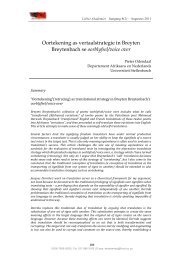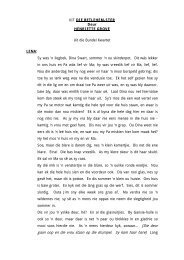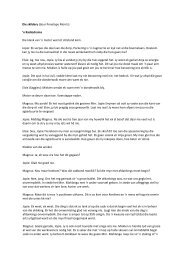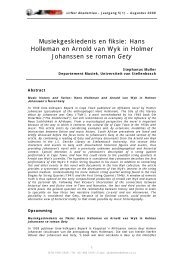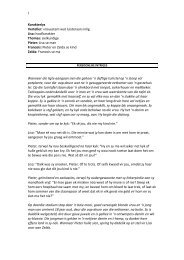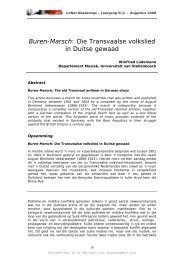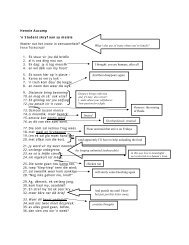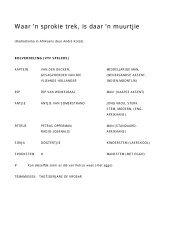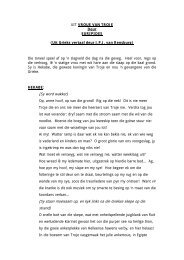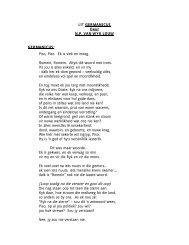Jaargang 8, nommer 2 – Augustus 2011 - LitNet
Jaargang 8, nommer 2 – Augustus 2011 - LitNet
Jaargang 8, nommer 2 – Augustus 2011 - LitNet
You also want an ePaper? Increase the reach of your titles
YUMPU automatically turns print PDFs into web optimized ePapers that Google loves.
<strong>LitNet</strong> Akademies <strong>Jaargang</strong> 8(2) <strong>–</strong> <strong>Augustus</strong> <strong>2011</strong><br />
In the section titled “Facial features, hair and power” the article explores how selected texts<br />
represent the importance that is attached to having “good hair”, which tends to be defined as<br />
long and straight. The opposite of “good hair” is hair that is short and frizzy, and having this<br />
latter kind of hair is regarded by characters as a kind of disability. These texts expose the<br />
extent to which real social power accrues to women with “good hair” since they live in<br />
societies where women’s life chances are profoundly shaped by their adherence to Eurocentric<br />
standards of appearance. The construction of beauty can never be separated from gender and<br />
power relations. Wolf (1991) argues that a system of male dominance is perpetuated by<br />
determining women’s value in a vertical hierarchy according to physical yardsticks of<br />
appearance. In this system, women are placed in the unnatural position of having to vie for<br />
resources that men have claimed as their own.<br />
In the South African society of the 1960s that is depicted in Stamatélos’s Kroes, social, political<br />
and economic power were heavily concentrated in the hands of white men. Women’s<br />
appearance can constitute a vital asset in the process of accessing some of this power, and the<br />
text reveals that they can sometimes accomplish this only through their association with<br />
white men. This association, in turn, depends on their ability to approximate the Eurocentric<br />
bench mark of beauty that the male characters seem to favour. Throughout the texts that are<br />
analysed in this section, one can identify a recurring tendency to associate beauty with<br />
whiteness. Brown female characters are shown to go to great lengths, and often endure<br />
significant pain, to render their hair as straight as possible. Despite the effort, time, expense<br />
and pain, changing the appearance of one’s hair is still more feasible than changing the<br />
colour of one’s skin, which explains why these women spend such seemingly disproportionate<br />
amounts of resources on their hair. All these efforts, however, can always only be temporary,<br />
since hair that is frizzy will keep returning to its natural state. Women are thus forced to<br />
remain in a constant state of vigilance and to be ever alert to the texture of their hair.<br />
In the section titled “Stigma and shame” the article explores how these pressures affect<br />
women’s understanding of themselves and their places in society. The texts that are analysed<br />
show how characters with “good hair” flaunt this asset, while those with frizzy hair go about<br />
their straightening efforts with a profound sense of shame. The failure to conform to<br />
Eurocentric ideals of “good hair” carries a stigma. In his seminal work on shame and stigma<br />
Goffman (1963) illustrates how stigmatised people suffer from discrimination in a variety of<br />
forms and how the discriminatory attitudes of others can drastically curtail the life chances of<br />
individuals. The experiences of the female characters in the texts bear out Goffman’s findings<br />
as the reader witnesses the shame and the secrecy that surround women’s negotiations with<br />
their hair texture. The phenomenon of shame has significant gender dimensions as women<br />
appear to experience the disempowering consequences of shame more extensively than men<br />
(Bartky 1990). Indeed, in the texts under discussion the female characters’ concern about<br />
their hair texture often contrasts sharply with the nonchalance of male characters in this<br />
regard.<br />
While women’s appearance can function as a mechanism for social advancement it can also<br />
be used as a point of reference against which their existing class position can be determined.<br />
The section titled “Appearance and class” demonstrates how characters associate “niceness”<br />
with light skin and “good hair”, where “niceness” serves as a euphemism for a middleclass<br />
status. Other euphemisms for an acceptable class position, such as decency and respectability,<br />
also crop up in the texts. Regardless of the exact terminology, however, such a status is<br />
repeatedly linked to appearing white. In Stamatélos’s text the narrator, Pattie, is as explict<br />
about this as equating her stepmother’s dark skin with being common and vulgar. Mona’s<br />
dark skin and, more importantly, the symbolic currency attached to this skin colour, makes it<br />
impossible for her to stay with Pattie in an area that is designated for white people under<br />
South Africa’s now defunct Group Areas Act. Yet Pattie’s ability to conform to Eurocentric<br />
standards of appearance enables her to stay in this area with the white man who is her fiancé.<br />
271<br />
ISSN 1995-5928 | Tel: 021 886 5169 | E-pos: akademies@litnet.co.za



